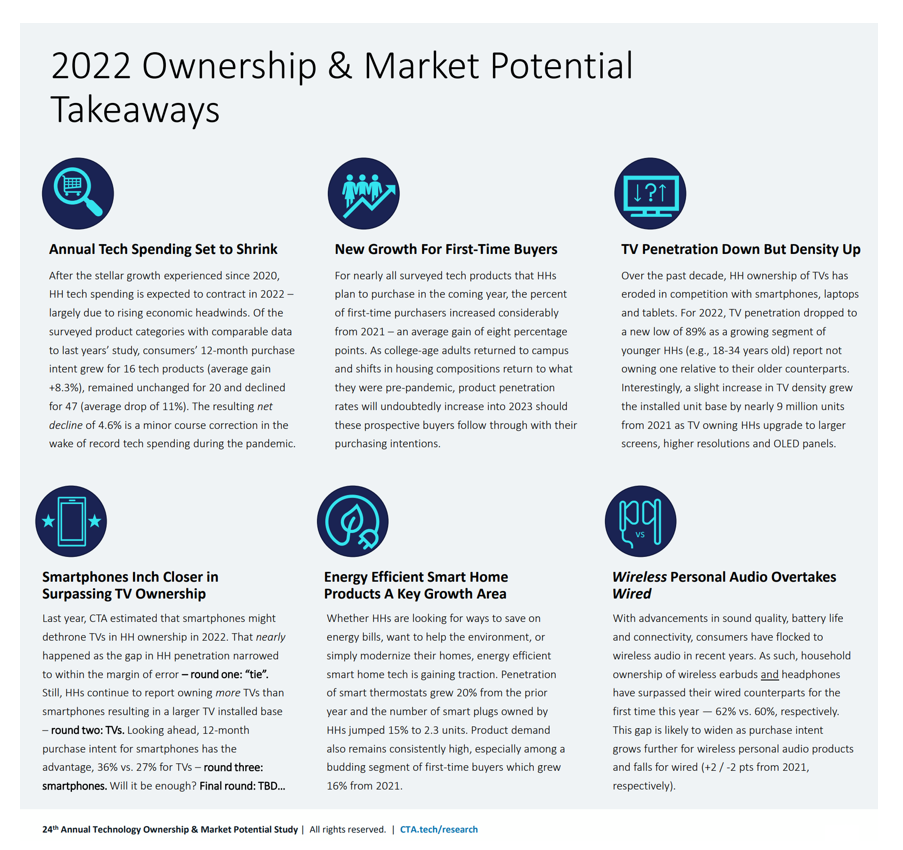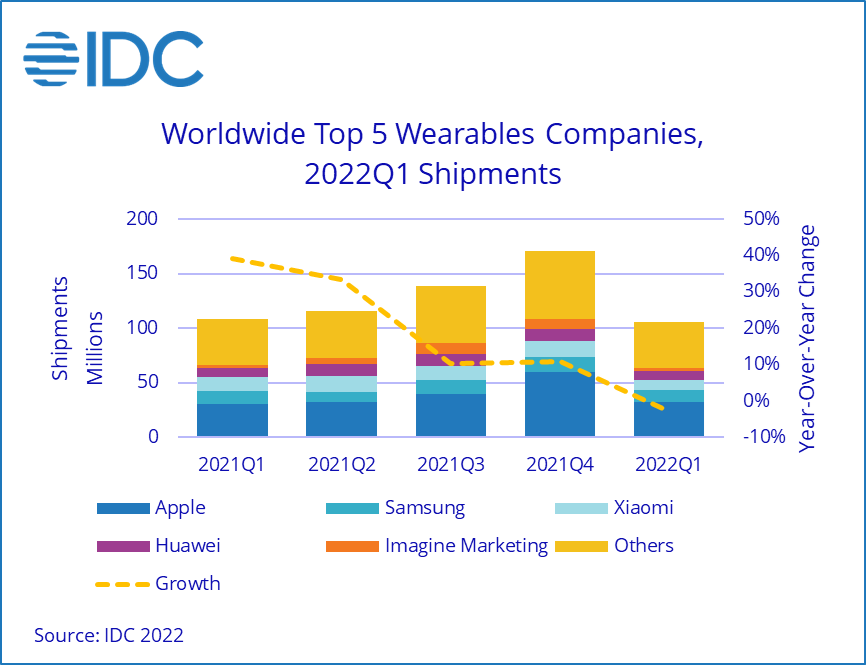Consumers continued to invest in and use several technologies that supported self-care at home in 2021, with plans to purchase connected health devices, sports and fitness equipment in the next year.

But these purchases will be made with greater attention to budget and value consumer mindsets firmly focused on (and stressed by) inflation.
The 24th Annual Technology Ownership & Market Potential Study from the Consumer Technology Association (CTA) tells us that Americans in 2022 will have to manage challenging economic headwinds, shopping for technology is preparing people for their new normal — with household budgets and value in mind.
This study assesses two measures of U.S. consumer household technology demand: current household ownership (penetration) and future purchase intent (with plans to purchase in the next 12 months). The poll was conducted among 2,630 U.S. adults 18 and over in April and May 2022.
CTA looked at ten categories of consumer tech for the research: mobile devices, video products, audio products, computing devices, video gaming, smart homes, wearable tech, automotive tech, health & wellness, and lifestyle tech.
The first chart identifies six over-arching trends of the research, noting that,
- Annual tech spending will slightly contract, depending on the tech category (with 16 tech products growing in adoption)
- The percent of first-time tech purchases will increase “considerably” from 2021, on average 8 percentage points
- TV penetration dropped to a new low of 89% with younger people employing other platforms for video viewing
- Smartphones are “inching closer” to surpass TV ownership
- Energy efficient smart homes are faster growing, and
- Wireless personal audio has overtaken wired audio for the first time.
![]()
Looking at self-care and health care in the home, several themes in the study are useful for our strategic, scenario, and business planning.
The list of top-ten technologies with the highest purchase intent illustrate platform devices that can be useful for peoples’ health and well-being when apps and tools are well-designed for the purpose.
Note that consumers’ smartphone 12-month intent-to-purchase ranked first among all other tech products, with 36% of households intending to purchase new smartphones in the next 12 months. This manifests a 9-in-10 household penetration for smartphones with an installed user base of 240 million U.S. adults. Furthermore, 26% of people intend to purchase a 5G phone.
Another hot area for consumer tech growth is smart speakers, for which new uses and skills are continuously being developed for health and well-being.
For the 5th year in a row, CTA found that smart speakers have the highest household penetration and purchase intent versus other smart home products int he study. 24% of U.S. households intend to buy a smart speaker in the next 12 months, two-thirds of whom are repeat purchasers. This will mark an installed base of 115 million and a 41% household penetration.
By May 2022, 1 in 5 U.S. households owned a smart or connected health monitoring device, with 22 million homes planning to buy at least one in the next year. In CTA’s study methodology, connected/smart health monitoring devices include digital thermometers, blood pressure tech, and sleep tracking devices.
Separately, CTA assessed wearable tech such as smartwatches and activity trackers, virtual reality headsets, and augmented reality glasses or headsets. There is a growing gap between smartwatch ownership and activity fitness trackers, with 41.6 mm households owning the former and 31.8 mm the latter by May 2022. 22% of U.S. households intend to purchase a smartwatch in the next 12 months, and 18% a wearable tracker. Over one-half of these buyers would be repeat purchasers in 2022.
Increasingly, consumers intending to buy a smartphone or fitness tracker will seek one that is cellular-equipped with a data plans (say, 4G LTE or 5G mobile broadband).
CTA concludes this year’s report with the observation that, while COVID-s influence “lingers,” there are now global tensions, inflation and negative impacts on consumers’ finances.
At the same time, consumers are looking to invest in technologies that enable personal decisions and freedoms – like smartwatches, 5G smartphones, and smart speakers that help make life and living at-home easier, accessible, and empowering.

Health Populi’s Hot Points: Most people see technology as part of everyday and every aspect of their lives, Wunderman Thompson learned in its research for the company’s Into the Metaverse report. Social lives, livelihoods, creative inspirations, and even happiness and wellbeing all depend on technology, most U.S. consumers say.
How will inflation and an economic downturn impact consumers’ views on adopting, acquiring, and continuing to use technology in daily life? The forces that have shaped peoples’ dependency on and appreciation for tech-in-life were complex and converging; so area the economic forces that have begun to impact the demand side of consumer technology purchases and use.

A cautionary report that should sober-up the most bullish of digital health enthusiasts came from IDC’s recent research published June 7 noting that, globally, wearable technology purchases fell for the first time since the firm has watched the space.
IDC sees this decline as “normalizing” demand, observing that wristband tracker sales fell by 40.5%, but hearables and smartwatch purchases increased to mitigate some of the falling shipments.
Keep in mind that, “Most Americans, regardless of political affiliation (68%), believe inflation is the most important issue facing them and their household,” CTA learned in research conducted among U.S. consumers in May 2022. At that time, nine in ten people were using at least one service from a major technology company at least several times a week, most frequently email, social media, and streaming video.
CTA expects inflation, geopolitical disruptions, a bearish stock market, and persistent supply chain challenges to depress consumer sentiment — which is a key driving force in consumers’ spending, traditionally the most important driver of the U.S. economy and GDP growth.
Inflation for general household basic needs — such as food, housing, energy/utilities and gas for transportation — has the potential to crowd out other household spending especially for people managing budgets living in mid-to lower income households. There is already concern in U.S. families about being able to afford health services and prescription drugs, found in a Civic Science survey conducted in early June.
All health care stakeholders can learn from CTA’s observation that consumers will be “budget-mindful” when shopping for tech.
You can also expect health-minded consumers to also be budget- and value-mindful in and beyond 2022…




 Thanks to Feedspot for naming this blog, Health Populi, as a
Thanks to Feedspot for naming this blog, Health Populi, as a